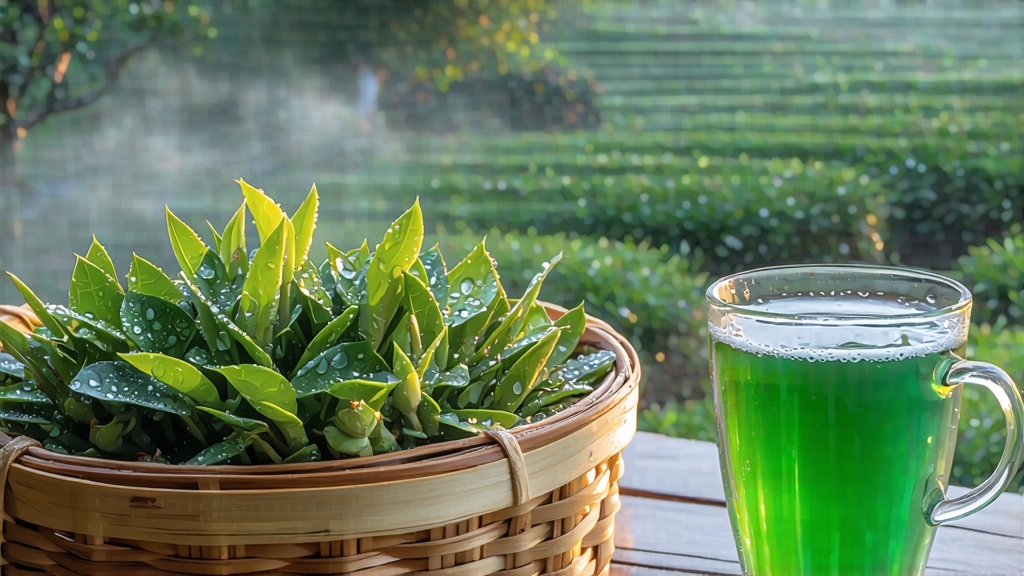
Biluochun, whose name translates literally to “Green Snail Spring,” is one of China’s ten most celebrated teas, yet it remains curiously under-represented on Western tea menus. Grown almost exclusively in the lake-studded hills of Dongting Mountain near Suzhou, Jiangsu Province, this fragile green tea is prized for its improbably tight spiral shape, downy silver tips, and a fragrance so perfumed that the Qing-dynasty Emperor Kangxi is said to have rechristened it on the spot, declaring that its curled form resembled tiny jade snails and its aroma rivaled that of spring itself.
The tea’s documented history begins during the late Ming dynasty, when local monks first planted tea bushes between fruit trees on Dongting’s east and west peaks. The intercropping was pragmatic: peaches, plums, and apricots flowered early, luring pollinators while shading the young tea leaves from the fierce lake-reflected sun. Over centuries the bushes absorbed the orchard’s volatile esters, giving Biluochun its signature fruity bouquet that lingers even before water touches leaf. By the early twentieth century the tea had become a tribute item shipped north to imperial courts via the Grand Canal, and its fame spread along with the silks and porcelains of Jiangnan.
Botanically, Biluochun is made from a small-leaf cultivar called “Xiao Ye” (literally “tiny leaf”) that is particularly rich in amino acids, especially L-theanine. The combination of cool lake mists, sandy loam, and sharp diurnal temperature variation forces the plant to metabolize slowly, concentrating both sweetness and fragrance. Within the narrow designation “Biluochun” there are three recognized grades: Supreme (Qingming前, picked before April 5), Superior (Qingming to Guyu), and Standard (Guyu to early May). Supreme grade consists solely of an unopened bud and the adjacent half-expanded leaf, no longer than 2.5 cm, and yields roughly 80,000 buds per 500 g of finished tea.
Crafting Biluochun is a race against oxidation and against the calendar. Picking starts at dawn when the dew is still cool; by 9 a.m. the baskets are carried to the village alleyways where withering trays of woven bamboo await. The leaves are spread no thicker than two centimeters and allowed to breathe for two hours, softening cell walls without losing the vivid jade color. Next comes the kill-green step, unique among Chinese greens for its low-temperature pan firing. A 90-cm diameter wok is heated to exactly 190 °C, then swabbed with a tuft of fresh tea-oil-soaked cotton. One handful of leaves—about 150 g—is tossed in; the master’s bare hands flutter like startled doves, flicking the leaf mass against the hot iron for precisely 3.5 minutes. The temperature is then dropped to 120 °C and the same leaves are rolled for another four minutes, forming the iconic tight spiral. Finally the tea is dried in three passes: first at 80 °C to reduce moisture to 20 %, then 60 °C to 10 %, and a last gentle 50 °C bake to lock in fragrance. From pluck to final bake the entire process spans no more than six hours.
To brew Biluochun properly one must respect its delicacy. Use soft spring water brought to 75 °C—any hotter scalds the down and releases a brassy bitterness. A tall, thin glass is preferred both for thermal control and for the visual drama: when the water hits the leaf, the spirals unfurl like green fireworks, sinking slowly in a choreography known among Suzhou poets as “the dance of the jade snails.” The standard ratio is 3 g of leaf to 150 ml of water; the first infusion lasts 45 seconds, the second 30, the third 50, and the fourth a full minute as the cells finally surrender their remaining aromatics. A fifth infusion is still fragrant but noticeably thinner, a gentle farewell rather than a dramatic exit.
Tasting Biluochun is a vertical journey through three layers of aroma. The dry leaf smells of ripe peach skin and fresh alfalfa; once wet, it exudes magnolia and honeydew; the liquor itself carries a marine note reminiscent of steamed edamame. On the palate the tea is almost weightless, a silken broth that expands into cool mint and white grape, finishing with a